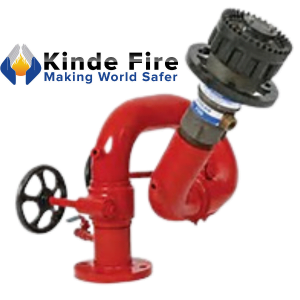The Role of Foam Monitors in Effective Fire Suppression
Firefighting can be challenging, especially when dealing with large fires involving flammable liquids like gasoline or oil. In such situations, foam monitors become incredibly important. These devices help firefighters control and put out fires by spraying a thick layer of foam over the flames. This blog will explain how foam monitors work, the types of foam used, and why foam is often more effective than water in fighting fires.
Introduction:
Foam monitors are specialized tools used by firefighters to spray foam over large areas, helping to put out fires quickly and effectively. They are especially useful in situations where flammable liquids are involved, as water alone might not be enough to control the fire. By creating a barrier between the fuel and the fire, foam monitors help stop the flames from spreading and prevent the fire from starting up again.

How Do Foam Monitors Work?
Foam monitors work by mixing water with a special foam concentrate, creating a thick, bubbly substance that can cover large areas. This foam smothers the fire, cutting off its oxygen supply, and cools down the burning material, making it less likely to catch fire again. The foam is sprayed through the monitor, which can be adjusted to reach different distances and cover the area as needed.
Types of Foam Used in Firefighting
There are several types of foam that can be used with foam monitors, each designed for different types of fires:
Aqueous Film-Forming Foam (AFFF): This is commonly used for fires involving flammable liquids like gasoline. It creates a thin layer over the liquid, stopping the fire from spreading.
-
1
Alcohol-Resistant AFFF (AR-AFFF): This foam is similar to AFFF but is designed to work on fires involving alcohols and other solvents, which might break down regular foam.
-
2
Protein Foam: Made from natural proteins, this foam is effective on hydrocarbon fires (like oil or gasoline) and lasts longer than synthetic foams.
💡Key Takeaway
Remember these important insights as you continue reading.
-
3
High-Expansion Foam: This foam expands quickly and is great for filling large spaces, making it ideal for areas like warehouses or airplane hangars.
Why is Foam Better Than Water?
While water is often the first thing people think of when fighting fires, foam can be more effective in certain situations. Here’s why:
-
✓
Better for Flammable Liquids: Foam is particularly good at handling fires involving flammable liquids, where water might not work as well. Water can spread the liquid, making the fire worse, but foam smothers it.
-
✓
Prevents Re-Ignition: Foam forms a thick blanket over the fire, cutting off the oxygen and preventing the fire from starting up again, which water alone might not do.
-
✓
Less Water Damage: Using foam means less water is needed, which can reduce water damage to buildings and equipment.
-
✓
Longer Lasting: Foam stays in place longer, providing ongoing protection and reducing the risk of the fire reigniting.
If you are looking for Foam Monitors for fire fighting equipment from India you are at right place. Please visit us at www.mobilefoamunit.in or www.kindefire.co.in to know more above the foam monitors.
You can also send us direct inquiry on our email id info@kindefire.co.in or hrathod@ithing-mtx.com. You can also reach us out at+91-8141899444
If you want to know more on fixed type and trolley or trailer mounted water & foam monitors you can visit our blog section at www.mobilefoamunit.in/blog.
How Effective Are Foam Monitors?
Foam monitors are highly effective in fighting fires, especially in large or hard-to-reach areas. They can be adjusted to control the amount of foam and the distance it covers, making them versatile tools for different fire scenarios. There are two main types of foam monitors used in firefighting:
-
1
Trolley Mounted Water Monitors: These are portable and can be quickly moved to where they are needed most. They are ideal for smaller fires or situations where a quick response is essential.
🎯Key Takeaway
Remember these important insights as you continue reading.
-
2
Trailer Mounted Foam Monitors: These are larger and can cover more area, making them perfect for big fires or when you need to spray foam over a long distance.
Final Words:
Foam monitors are crucial tools in firefighting, especially when dealing with fires involving flammable liquids. They help control and extinguish fires more effectively than water in many situations, preventing further damage and saving lives. Understanding how foam monitors work and why foam is often a better choice than water can make a significant difference in fire safety. As fire risks continue to evolve, foam monitors will remain a vital part of any firefighting strategy.